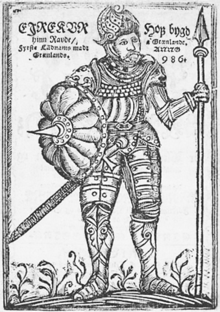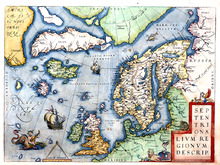Erik the Red

Erik "the Red" Thorvaldsson ( old north. / Iceland. Eiríkr / Eiríkur rauði Þorvaldsson , norweg. Eirik Raude , * around 950 in Jæren , Norway ; † around 1003 in Brattahlíð , Greenland ) was a Norwegian-Icelandic seafarer and explorer.
He is known as the founder of the first Scandinavian settlement in Greenland . His nickname the red arose because of his red hair and beard and because "blood was stuck to his hands". The Eiríks saga rauða bears his name.
Life
Erik was born in Norway as the son of Þorvaldur Ásvaldsson , so his real name was Erik Þorvaldsson "the red" (Eiríkur rauði Þorvaldsson). As usual in the old Scandinavian languages, Þorvaldsson or Ásvaldsson are not surnames, but a patronymic .

Erik's father had to flee Norway around 970 because he had committed a murder. The family settled in Iceland . Erik was expelled from Iceland for three years in 982 because he had also committed a murder there. Before he decided to look for a land in the west that had previously been sighted by Gunnbjörn Úlfsson and was known as Gunnbjörns Archipelago ( Gunnbjarnarsker ), he withdrew from the judicial district in which it was pronounced due to the judgment passed. However, he could not live unmolested there either, as he now bore the stigma of a murderer. Thereupon he drove west without a wife and children, whom he only met again four years later.

After the saga he spent the three years exile on Greenland, whose coasts he explored. Due to the long winters, Erik and his team came close to starvation several times. Then he returned to Iceland and recruited colonists. The name Greenland (green land) is ascribed to it, with effective advertising. With 25 ships and many people he went to Greenland in 985 . 14 ships arrived, 11 were lost at sea. The Icelanders founded two settlements, the Eystribygð (New Icelandic: Eystrybyggð) in the south near today's Narsarsuaq and Vestribygð (New Icelandic: Vestribyggð) near what later became Nuuk . In Eystribygð Erik established his farm Brattahlíð .
The settlements flourished and grew to over 3,000 residents as there was more influx from Iceland. A severe blow was an epidemic that brought new colonists to Greenland in 1002 and of which Erik fell victim. The colony recovered, however, and existed until the 15th century, although regular shipping with Europe stopped earlier.
As far as is known, Erik had four children: Leif Eriksson , the discoverer of Vinlands (Newfoundland), Thorvald Eiriksson , Þórsteinn Eiríksson and Freydis Eiríksdóttir .
Reception in modern culture
The Eirik Raude (Norwegian) oil rig is named after Erik the Red .
The part of Greenland on the north east coast occupied by Norway from 1931 to 1933 was called Eirik Raudes Land .
The album “Eric the Red” by the Faroese metal band Týr is named after Erik, the German pagan metal band Black Messiah tells the story of Erik in the song “Erik, Der Rote” on their album “Of Myths And Legends”. The concept album “Durch Blut und Eis” by the German Viking metal band Thrudvangar is completely dedicated to Erik the Red and the German power metal band Rebellion also tells its story in the song “Eric the Red”.
"Erik the Red" is also the name of a cartoon character from Marvel Comics . The name was used by three different comic characters as a hidden identity with the same costume: Cyclops , Davan Shakari and Magneto .
In the Asterix comic The Great Crossing , the leader of the Normans, who wants to discover a new country and then bring Asterix and Obelix back to Europe as natives of America, is called "The Red Erik". At the end he asks himself the question "May I be an explorer or not?"
In Fabian Lenk's collection The Time Detectives with Wild Vikings , the contemporary thriller The Curse of the Vikings Erik, the red after returning from exile, is the theme: Julian, Kim, Leon and the cat Kija get to know Erik's son Leif, as Erik many Icelanders for the Passionate to Greenland enthusiastic. After an attack and a heavy sea storm, they can only reach Eriksfjord with 11 instead of 25 ships. While the new settlement is being built, they are attacked by strangers and later Erik's son Leif is captured. This is the act of revenge of Thorgest, whose sons Erik had killed in a fight and therefore Erik was sent into exile. When the fighters Thorgest and Eriks are furiously fighting, Julian calls on both sides to lay down their arms and build the settlement together. Leif is released and the opponents join forces.
literature
- Arnulf Krause : The world of the Vikings. Campus-Verlag, Frankfurt am Main / New York 2006, ISBN 3-593-37783-7 , pp. 179-182.
- Hans-Jürgen Krüger : Erik the Red and Leif the Happy. A biography of the Erik family. Bormann von Bockel, Hamburg 1990, ISBN 3-927858-05-6 .
- Lutz Mohr , Robert Liese: Vikings between Pomerania and the Arctic Circle. Sagas or truth . Horn-Bad Meinberg: Leo-Verlag Robert Liese 1997, 2nd edit. 2000 edition. Chapter: Erik the Red - The Greenland Explorer , pp. 110–120. ISBN 3-9805594-0-8
- THULE, Old Norse Poetry and Prose, Volume XIII: Greenlandic and Faroese Stories . Ed. And trans. by Felix Niedner . New edition with afterword by Siegfried Beyschlag . Düsseldorf-Cologne: Eugen Diederichs Verlag 1965
- Fabian Lenk : The time detectives with wild Vikings Ravensburger Buchverlag, Ravensburg 2013, ISBN 978-3-473-36973-7 , p. 163ff.
Web links
- Literature by and about Erik the Red in the catalog of the German National Library
- "Erik the Red", on nationalgeographic.de
- Career of an angry man in: Der Spiegel Geschichte, issue 06/2010 from November 30, 2010
Individual evidence
- ^ Farley Mowat, Westviking: The Ancient Norse in Greenland and North America (1965) ISBN 978-0-7710-6692-4
| personal data | |
|---|---|
| SURNAME | Erik the Red |
| ALTERNATIVE NAMES | Eiríkur rauði Þorvaldsson |
| BRIEF DESCRIPTION | Founder of the first Viking settlements in Greenland |
| DATE OF BIRTH | around 950 |
| DATE OF DEATH | around 1003 |
